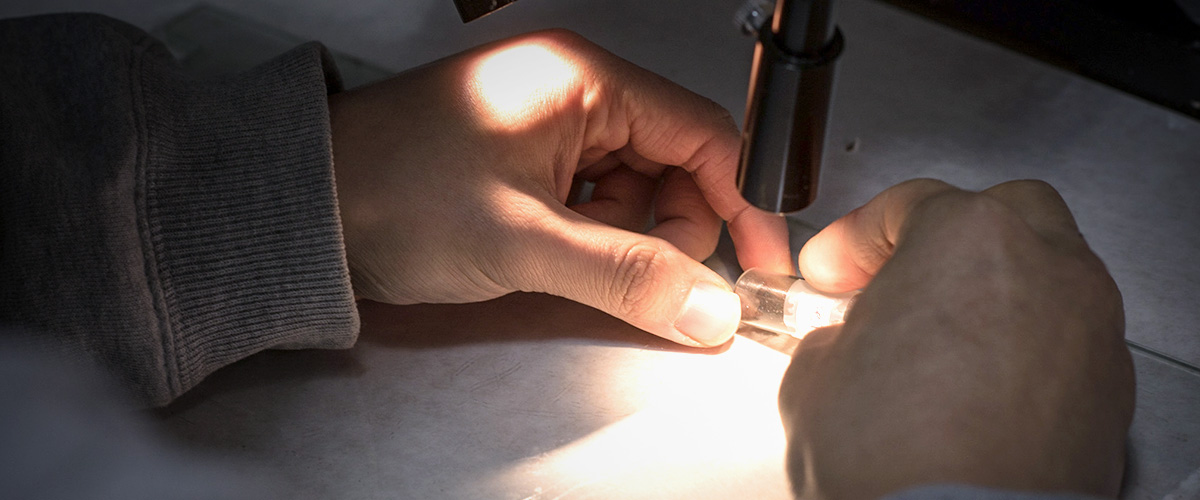Air-sensitive or Reactive
Extremely sensitive samples are best sealed at the user's site in a quartz tube. Other sensitive samples can be put into a Teflon or plastic container and enclosed into another airtight container from which a sample can be transferred quickly into the instrument, where it should be safe in the He atmosphere.
Compatible instruments:
- Broadband Backward Wave Oscillator (BWO) Spectrometer
- Broadband Millimeter Wave Vector Network Analyzer (MVNA) Spectrometer
- Heterodyne Quasi-Optical Spectrometer
- Transmission Spectrometer
- W-Band HiPER Spectrometer
- XW-Band Bruker Pulsed Spectrometer
Frozen Solutions
Biological samples that cannot be obtained in the dry state are often studied in frozen solutions. Otherwise, frozen solutions are sometimes used instead of powder samples to reduce the intermolecular interactions that may blur the hyperfine structure. Most solvents pose no problems in EPR when frozen, even those that strongly absorb microwaves in their liquid state, like water.
Compatible instruments:
- Broadband Backward Wave Oscillator (BWO) Spectrometer
- Broadband Millimeter Wave Vector Network Analyzer (MVNA) Spectrometer
- Heterodyne Quasi-Optical Spectrometer
- Transmission Spectrometer
- W-Band HiPER Spectrometer
- XW-Band Bruker Pulsed Spectrometer
Liquids
It is a sample type in liquid phase, typically a solution in water, organic solvent, or a mixture. For instance, most of biological samples are using water as a solvent, such as spin-labeled proteins and nuclear acids, metalloenzymes, biological membranes, membrane associated proteins and peptides, free radicals in cells and tissues, et al. As another example, organic solvent is commonly used in EPR studies to dissolve chemical compounds and molecular complexes that contain free radicals or transition-metal ions.
Compatible instruments:
Powders & Polycrystals
A powder sample is a good alternative to a single crystal sample. Much less measurement time is needed and most of the information that is available from a single crystal spectrum can be extracted also from a powder spectrum, particularly in high-field EPR.
Compatible instruments:
- Broadband Backward Wave Oscillator (BWO) Spectrometer
- Broadband Millimeter Wave Vector Network Analyzer (MVNA) Spectrometer
- Heterodyne Quasi-Optical Spectrometer
- Transmission Spectrometer
- W-Band HiPER Spectrometer
- XW-Band Bruker Pulsed Spectrometer
Single Crystal
A single crystal has the advantage that it can provide information not only of the size of the EPR parameters, but also the direction of principle axes of Zeeman and fine structure (ZFS) tensors, as well as anisotropic exchange. If the concentration of spins in the crystal is low enough also hyperfine interactions tend to be better resolved, and provides better signal to noise for double resonance experiments like ENDOR. However, typically measurements takes more time as a range of orientations need to be measured. Some of our spectrometers are equipped with single axis rotation for single crystal experiments.
Compatible instruments:
Thin Films
The use of thin films on substrates are important for various applications and for EMR is especially useful for the study of magnetic substances because of the relatively homogeneous demagnetization field. Sample size up to 1/2" diameter can be accommodated and film thicknesses can range from 20-2000 nm, depending also on spin concentration and resonance linewidth. The field can be applied in the plane of perpendicular to the plane of the film. It is possible to have leads on the sample for simultaneous measurement of resistivity, as long as they allow good optical access to the surface in typically a 4x4 mm area.
Compatible instruments:



